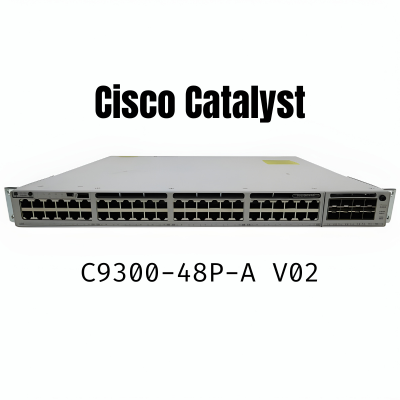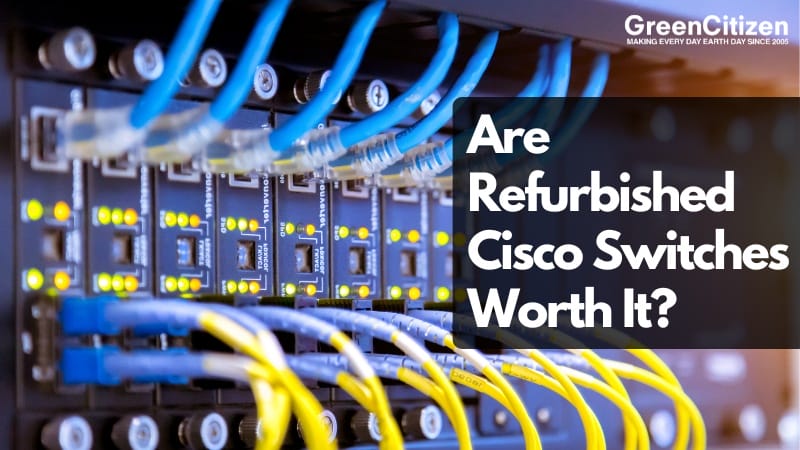Is it safe to build your network on refurbished Cisco switches? It’s a fair question — especially when balancing performance needs against the cost of new hardware. A well-restored switch can deliver enterprise-grade reliability at a much lower price, but only if you understand what to look for.
From choosing between a Cisco 3850 refurbished and a Cisco 9300 refurbished, to navigating firmware, licensing, and warranty differences, it’s easy to feel stuck between saving money and staying compliant. Not all Cisco refurbished switches are equal — and the label alone doesn’t guarantee quality.
This guide breaks down what makes refurbished Cisco switches and routers worth considering, how to evaluate their reliability, which models offer long-term value, and what signs to trust when choosing a seller.
Key Takeaway: Are Refurbished Cisco Switches Worth It?
Refurbished Cisco switches and routers can deliver reliable enterprise performance—at a fraction of the cost—when restored and tested correctly. Always verify the refurbishment process, warranty, and seller credibility. Trusted refurbished Cisco equipment offers serious value for IT teams balancing uptime, performance, and budget.

Buy the Best Refurbished Cisco Switches
- Over 350,000 customers served
- 99.3% positive feedback
Professionally tested, cleaned, and prepared
What Are Refurbished Cisco Switches?
A refurbished Cisco switch is a pre-owned network switch that’s been professionally restored to meet specific operational, cosmetic, and compliance standards. These aren’t just cleaned and resold — they’re systematically reconditioned using Cisco-grade procedures or equivalent testing workflows by certified refurbishers.
What Happens During Network Switch Refurbishment?
1. Initial Diagnostics and Visual Inspection
Every port, fan, power supply, and LED indicator is tested for baseline functionality. The switch is inspected for physical damage, corrosion, bent pins, or cracked casings.
2. Component-Level Restoration
- Fans and power supply units (PSUs) are tested under load — and replaced if noise, voltage irregularities, or heat issues are found.
- Flash storage, SFP slots, and network ports are tested with loopback diagnostics and traffic emulation tools to ensure error-free data flow.
- Internal heat sinks and thermal pads are cleaned and reinstalled or replaced to maintain cooling performance.
3. Firmware Standardization
The device is wiped, reimaged, and updated to a Cisco-approved IOS version to ensure compatibility and security. In Cisco’s official program, units are re-licensed when applicable.
4. Cosmetic Restoration
- Dust, debris, and label residue are removed using anti-static cleaning tools.
- Chassis scratches are minimized or buffed. Faceplates are replaced if worn.
5. Full Burn-In Testing
Refurbished Cisco switches undergo 8–24 hours of burn-in testing under simulated workloads. This stress test helps identify early failures under sustained throughput, power draw, and switching operations.
6. Final QA and Certification
Units are tagged, logged, and repackaged. Certified refurbishers also include a test report, warranty details, and asset ID for inventory tracking.
It’s important to distinguish between used, refurbished, and Cisco certified refurbished:
- Used: Sold without inspection or repair. Risk of failure is higher. No warranty.
- Refurbished: Restored by third-party sellers. Quality varies by vendor.
- Cisco certified refurbished: Officially refurbished by Cisco or authorized partners. Includes warranty, full testing, and support eligibility.
For IT teams managing cost without compromising network performance, refurbished Cisco switches offer a smart balance between value and reliability — especially when sourced from verified or Cisco-authorized inventories.
Are Refurbished Cisco Switches Reliable for Enterprise Networks?
Reliability is non-negotiable in an enterprise network — and refurbished Cisco switches can absolutely meet that standard, if they’ve been properly reconditioned.
A well-refurbished switch should handle 24/7 uptime, high port density, VLAN segmentation, PoE demands, and rapid failover just like its brand-new counterpart. But here’s the truth: not all refurbished Cisco switches are created equal. Reliability depends less on the word “refurbished” and more on how the unit was restored — and by whom.
Key signs of a reliable refurbishment:
- Hardware diagnostics reports verifying port function, PoE output, and power supply stability.
- Consistent firmware loading and boot time with error-free logs.
- Passed burn-in testing under simulated traffic loads to mimic real-world use.
- Clean, unmodified chassis free from heat damage, board repair traces, or aftermarket modifications.
- Documented asset tagging and warranty information, ideally including test logs or certification reports.
If a seller can’t offer transparency around these details, assume corners were cut.
In enterprise environments — where downtime means lost revenue — it’s critical to evaluate not just the switch, but the refurbishment process behind it. When those checks are in place, refurbished Cisco switches aren’t just reliable — they’re often the smartest way to stretch your IT budget without sacrificing performance or uptime.
Cisco 3850 Refurbished vs Cisco 9300 Refurbished: Which Is Better?
When comparing refurbished Cisco switches, the Catalyst 3850 and Catalyst 9300 are two of the most in-demand models — and for good reason. Both support enterprise-grade networking with advanced Layer 3 features, stacking, and strong PoE capabilities. But they serve slightly different needs, especially when it comes to future-proofing.
Here’s how they compare:
| Feature | Cisco 3850 Refurbished | Cisco 9300 Refurbished |
|---|---|---|
| Launch Year | 2013 | 2017 |
| Stacking Bandwidth | Up to 480 Gbps | Up to 480 Gbps (StackWise-480) |
| Uplink Options | Modular (1G/10G SFP) | Modular (1G/10G/25G SFP+) |
| Software | IOS XE | IOS XE (more recent builds) |
| PoE/PoE+ Support | Yes | Yes + UPOE support in select models |
| MACsec (802.1AE Encryption) | Limited | Supported |
| SD-Access/TrustSec | Not supported | Supported (intent-based networking) |
| End-of-Life Status | Approaching EOL (in some SKUs) | Fully supported |
| Use Case Fit | Mid-sized networks, basic enterprise deployments | Modern enterprise networks with security focus |
Both models perform exceptionally well in refurbished condition — assuming they’re properly restored and tested. For most IT environments, either will provide the switching performance you need, with 9300s offering more runway for future network upgrades.
Which Refurbished Model Is Right for You?
- Choose the Cisco 3850 refurbished if you need proven reliability at a lower cost and don’t require next-gen features like SD-Access or advanced MACsec encryption.
- Opt for the Cisco 9300 refurbished if you’re upgrading core infrastructure, want better future support, or need compatibility with newer Cisco DNA Center tools.
Are Refurbished Cisco Routers a Reliable Option for Business Networks?
Switches handle traffic within a network, but routers direct traffic between networks — and for many IT teams, refurbished Cisco routers are just as essential to consider.
Like switches, a refurbished Cisco router goes through a structured reconditioning process: internal flash storage is wiped and reloaded with stable IOS builds, routing tables and ACLs are cleared, and physical ports are tested with real traffic. For enterprise models, modular interface cards (e.g., NIMs, SM-X) are tested individually or replaced if needed.
Common choices in the Cisco refurbished inventory include:
- ISR 4000 series (branch-level routing with VoIP and VPN support)
- ASR 1000 series (high-throughput aggregation routing)
- Cisco 2900 and 3900 series (legacy but still in use across schools and midsize offices)
When buying refurbished Cisco routers, reliability depends on the same factors as switches:
- Verified port and throughput testing
- Clean software load with no prior configurations
- Power supply integrity
- Physical condition and audit documentation
While not all routers in the secondary market meet these standards, well-refurbished units can offer full routing functionality — ideal for labs, branch offices, or businesses needing affordable WAN redundancy.
Where Can You Buy Cisco Certified Refurbished Switches?
Buying Cisco certified refurbished switches isn’t just about finding the lowest price — it’s about sourcing from a seller that prioritizes quality, transparency, and long-term reliability.
Many listings online use terms like “Cisco authorized refurbished” or “professionally tested,” but offer little evidence to back it up. Without clear test logs, condition reporting, or warranty details, buyers are left guessing.
At GreenCitizen’s Green Store, every refurbished Cisco switch is:
- Professionally cleaned, tested, and restored to meet enterprise-grade performance standards
- Backed by the experience of over 350,000 customers served through our refurbished electronics program
- Protected by our commitment to quality — reflected in our 99.3% positive customer feedback

Buy the Best Refurbished Cisco Switches
- Over 350,000 customers served
- 99.3% positive feedback
Professionally tested, cleaned, and prepared
We don’t just list from generic Cisco refurbished inventory — we hand-pick and verify each unit. Only the top 1% of items we process make it into our store, meaning you get fully functional hardware, clean chassis, stable firmware, and dependable uptime — all without the inflated cost of new.
Whether you’re sourcing for a business upgrade or building a test lab, our Cisco switches are ready for deployment the moment they arrive.
Final Takeaway: Should You Buy Refurbished Cisco Equipment?
Refurbished Cisco switches and routers offer enterprise-grade performance at lower cost — if restored and sourced properly.
They’re ideal for IT teams who want tested, reliable hardware without overpaying for new.
Just be sure to evaluate the refurbishment quality, warranty, and seller transparency before buying.
When those boxes are checked, refurbished Cisco gear is one of the smartest infrastructure investments you can make.
